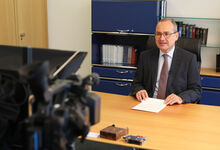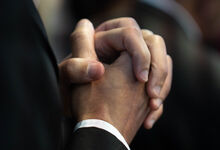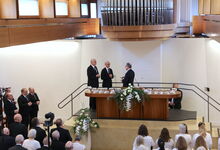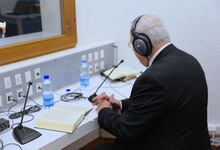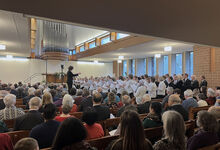Praying with the body
Why do we pray the way we pray? And isn’t it irrelevant what posture we take when we pray? Whether we pray standing, sitting, or lying down, or have our hands folded or our arms wide open—does it really matter? Well, this much is clear, sometimes a gesture or a posture is worth a thousand words.
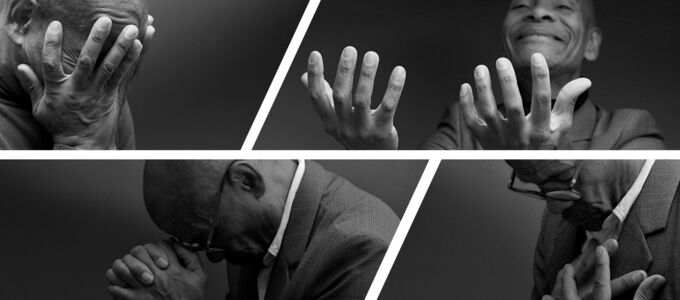
The Catechism clearly says: “Prayer is not bound to any external form.” Nonetheless, the intensity of a prayer can be influenced and promoted by adopting an appropriate posture.
For Origen, an early Christian scholar, prayer meant opening the soul to God. Since body and soul influence each other, our posture when praying definitely has an effect on our inner disposition. Opening ourselves physically to God, and actively and physically turning to Him supports our spiritual communication.
Let’s also keep in mind that our inner attitude is reflected in our outer bearing. Our devotion to God and our expectation of His closeness and presence should be visible. When we start to pray we stop what we were doing and withdraw from the busyness of our life.
And this is how various different postures in prayer came to be known.
Standing
In antiquity, early Judaism, and in early Christianity, standing was the basic posture when praying. At all religious activities, those present stood to pray together. If a respected personality enters a room, those present rise. In the same way, those taking part in a divine service express their respect for God: He is present. He is the object of our veneration, not our neighbour in the pew. Together, the congregation rises and stands before God.
This position is often mentioned in the Scriptures. For example, Abraham stood before the Lord and prayed for the righteous in Sodom (Genesis 18: 22). Or when Jesus spoke to His disciples about forgiveness He told them, “And whenever you stand praying, if you have anything against anyone, forgive him” (Mark 11: 25).
Kneeling
There are situations in life that bring everyone to their knees. In view of the coming events, Jesus knelt down in Gethsemane and humbly submitted to the will of God (Luke 22: 41).
Prostrating oneself and kneeling before God, whether face down or face up, is an expression of one’s own incapacity and helplessness. Abraham fell facedown before God when He made the covenant with him. Moses prostrated himself before God to intercede for the people.
Whether Joshua, Elijah, Daniel, or Peter and Paul: they were all in situations that forced them to fall on their knees before God and pray. And God always responds to a praying and struggling soul. Because after kneeling and having prayed one has to get up again and move on, even if this seems difficult at first. The examples in Scripture make it clear: the men and women who knelt down before God were lifted up by Him.
What do we do with our hands?
Those who consciously make time in their everyday routine to pray, will put things aside and fold their hands. Even in a figurative sense, supplicants stand before God empty-handed. The usual posture for prayer is with folded hands. This is how Christians pray in church services. And many also clasp their hands when they pray individually and privately.
However, folded hands or holding the palms of both hands together only emerged late in the Christian tradition. This is attributed to a Germanic gesture of devotion. A serf would fold his hands and willingly place them in the hands of his lord. In this way, he was making a commitment to his lord and demonstrating his loyalty and reverence. Hands that are folded in prayer are also a sign of concentration and inner contemplation.
In the Scriptures, people would often stretch out their arms and pray with their hands open and raised to heaven. Whether it was Apostle Paul or Abraham or Solomon, this is how they expressed their supplication as well as their readiness to receive something from God. Another interpretation is the wish to be guided by God.
Some pray with their hands in front of their faces, others place them over their hearts. Such postures are always a sign of an inner attitude and a person’s concentration on his or her dialogue with God.
Pray without ceasing
Whether it was Jesus, Abraham, or the others mentioned above. No one prayed in just one way. There are many more that could be mentioned. There was Daniel, for example, who sat down to pray. Or there was the publican who beat his breast in prayer. As Chief Apostle Schneider made clear in his New Year’s address, the point is that we should pray consistently in every situation in life. There are no rules or guidelines whatsoever that need to be observed in our personal prayers. All we need to be aware of is: “God hears me.”
Body language is just as important as the spoken word. Researchers estimate that up to ninety per cent of communication is non-verbal. This includes our body language when we pray. Our own posture can vary from one situation to the next. If the situation is one in which we desperately seek God, it is a conversation. Or maybe it is a call or a cry? Or does our prayer have the character of a complaint or a request? Or maybe our attitude is even one of thanksgiving and praise.
Photos: Anbieter: herlanzer - stock.adobe.com


